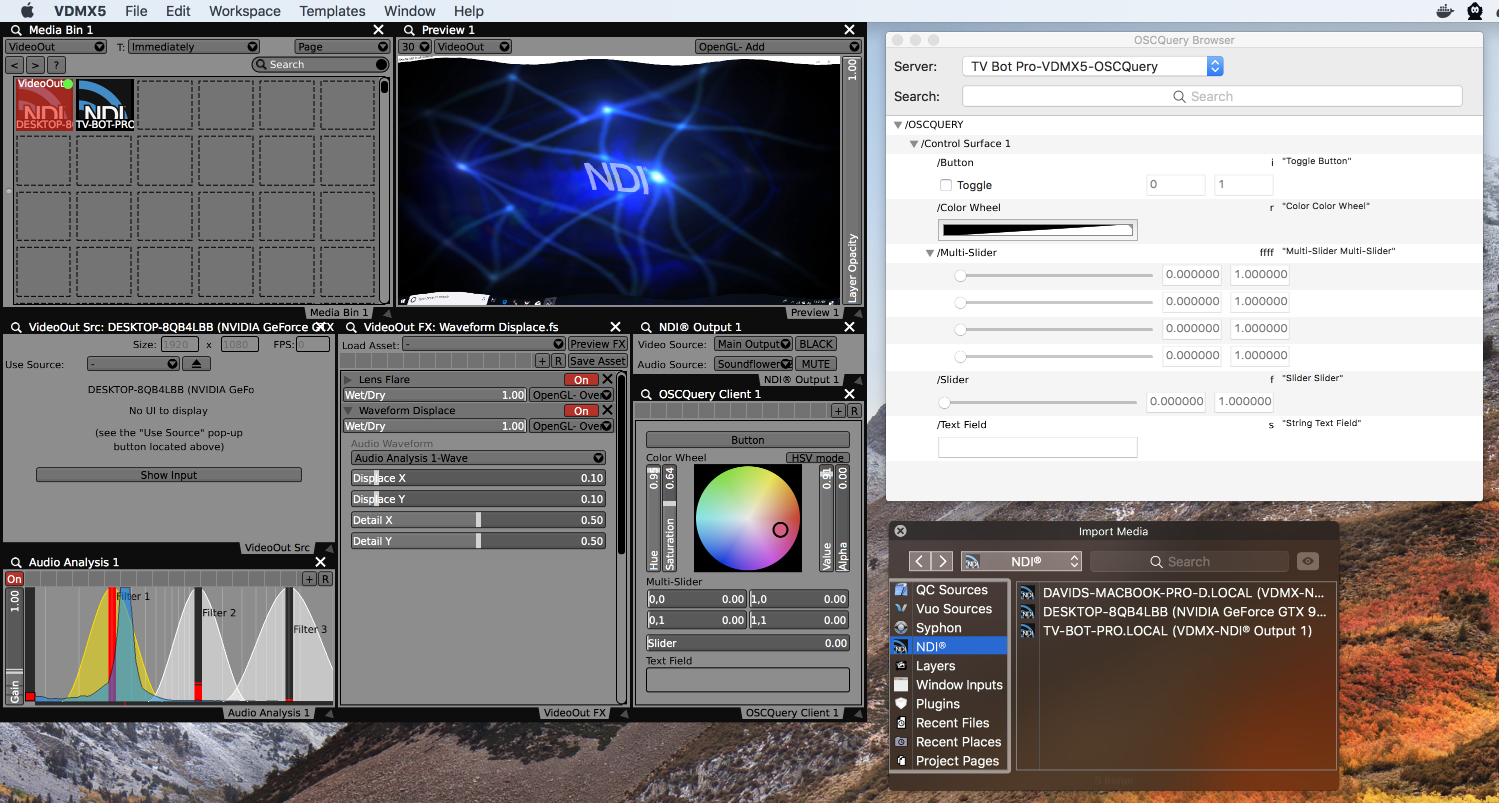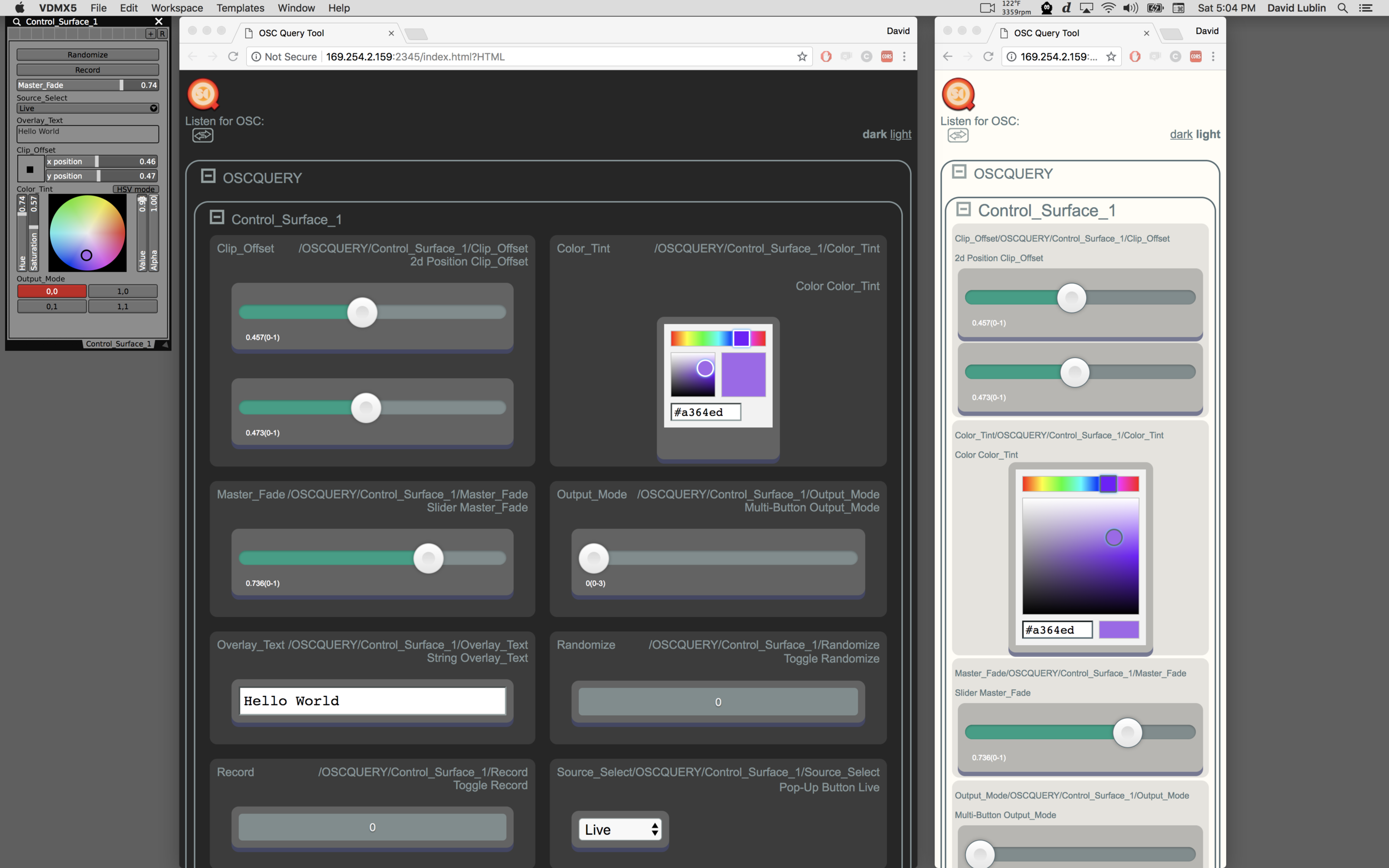Today we are excited to announce the release of a new update to VDMX that adds several major new features and some noteworthy smaller additions and improvements!
SO MANY NEW FEATURES IN THIS UPDATE!
NDI® Support in VDMX
VDMX is now capable of sending and receiving a/v streams over a network using the NDI® protocol from Newtek. Multiple streams can be used in each direction, within the limitations of your network bandwidth and system resources.
Sending and Receiving NDI® Video Streams in VDMX
Sending and receiving NDI® video streams in VDMX
VDMX is now capable of sending and receiving a/v streams over a network using the NDI® protocol from Newtek. Multiple streams can be used in each direction, within the limitations of your network bandwidth and system resources.
NDI® receiving streams can be directly accessed from the Use Source menu in the Layer Source Control panel. Selected streams will automatically be enabled if not already turned on and additional setup can be found in the VidIn section of the Workspace Inspector.
The NDI® Output plugin can be used to publish video and audio streams from VDMX to other client software and devices that support the protocol. Like other plugins, you can add any number of them to your project from the Plugins section of the Workspace Inspector.
More information about using NDI® in VDMX can be found on the tutorial pages for sending and receiving NDI streams, and in the documentation.
Along with native support in VDMX we have also published a new free lightweight NDISyphon utility application which can be used to send and receive Syphon streams between software over a network using NDI®.
OSCQuery Protocol
The new OSCQuery Protocol is an extension to OSC that we have been working with along with several other developers as a way to make setting up connections between software easier by allowing applications that receive messages to also publish their namespace in such a way that other software can ask for. This makes it possible to do useful tasks such as automatically creating UI elements to remotely control parameters of other tools, with the goal of constructing impromptu or improvisational interfaces for dynamic environments..
We've also published several new free / opensource OSCQuery utility apps that can be found in the Extras folder on the VDMX dmg, or downloaded individually: OSCQuery Browser, OSCQuery Helper and MIDI OSCQuery Helper.
More about OSCQuery Protocol can be found in the announcement blog post for the specification and there are new tutorials that demonstrate how to take advantage of it in VDMX. Developers interested in OSCQuery can read the full proposal and specification on the GitHub project page for OSCQuery.
Web Page Control
Along with support for OSCQuery, you can now publish parameters from VDMX and access them from a web browser on a desktop, mobile or tablet computer on your local network, simply by entering a URL.
Behind the scenes VDMX now acts as a web server that provides an automatically generated HTML interface for sending OSC messages to control your visuals. Using bi-directional communication VDMX can relay the state of parameters back to devices to keep multiple clients in sync.
More information about this feature can be found on the OSCQuery tutorial page.
A Control Surface plugin and corresponding web controller views (in dark and light stylings) on a Mac.
The corresponding interface viewed in Safari on an iPhone.
GPU / eGPU Switching
New option in Rendering preferences for GPU selection.
In this update in the Rendering preferences is a new option for specifying which GPU is currently actively being used by VDMX; this includes both older Mac Pro systems with multiple built-in GPUs and the latest Mac hardware which can connect external GPU (eGPU) units over Thunderbolt 3 connections.
As a note, overall we have found that eGPUs aren't a great solution for VJing from laptops: for general usage we still recommend getting a high end built-in GPU whenever possible. However, eGPUs do already have a lot of potential in a few particular use cases and we are excited to see how this technology evolves in the coming years.
Visit the VDMX documentation page on Using Multiple GPU Systems for further notes and discussion.
New ISF Generators and FX
No update is complete without new GLSL shaders to create and process visuals!
Added new generators: Brick Pattern, Etch-a-Sketch, Graph Paper, Radial Spectrogram and Random Shape Blast.
Added new FX: Boxinator, Dirty Lens, Random Freeze, Noise Adapt, Resize Glitch, Displace, Power Warp, Color Blowout, Edge Trace, Quad Mask, Sliding Strips, Waveform Displace, Noise Pixellate Multi-Pixellate, and Noise Displace.
Timecode Jam Sync Mode
We've added a new "jam sync" option for MTC and LTC modes in he timecode plugin- timecode will continue if MTC or LTC streams are interrupted unexpectedly.
BUG FIXES AND UPDATED DOCUMENTATION!
Always popular! See the release page for full details.
And in case you missed it, we recently updated the manual pages with a new layout, and you can now also find new information about using OSCQuery, eGPUs and NDI® in VDMX.
TRY IT OUT!
Here is the link to download the latest update: Download VDMX
And as always we love to hear feedback so please keep in touch by email, Twitter, Facebook or on our forums!


